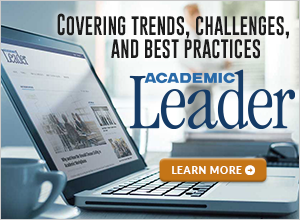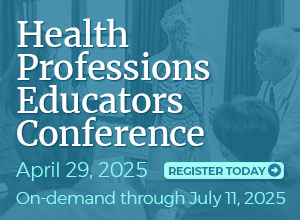In a 1969 song, Joni Mitchell tells us of how she’s looked at life from “Both Sides, Now.” That is sage advice for considering how Universal Design for Learning (UDL) can benefit students when faculty and administration examine their hopes (and fears) for creating a new learning experience.
At two recent conferences within a single week, I led discussions about adopting UDL as a pedagogical approach for supporting diverse groups of student learners.
At the beginning of the week, I participated in a breakfast conversation for chief academic officers (CAOs) from across the United States. They expressed their frustrations in trying to get faculty and administration to collaboratively support students according to a single shared vision for their academic departments. The CAOs encountered so much faculty resistance that, despite their leadership roles, they felt unable to make the vision a reality.
A few days later, I facilitated a discussion at a UDL in higher education conference at which most participants were instructors from throughout the country. This time I heard that while faculty would like to create a culture of teaching excellence on their campuses, they perceived school leaders as paying lip service to such initiatives and failing to provide the leadership and support needed for such a significant culture change to take place.
So what is needed for college administration and faculty to successfully create a culture of UDL in service to their students?
In 2017, Goodwin University in East Hartford, Connecticut, formally adopted UDL as our pedagogical approach to support our students. According to CAST (n.d.), which developed it, UDL is a “framework to improve and optimize teaching and learning for all people based on scientific insights into how humans learn.” The framework focuses on three principles of learning: engagement (the why), representation (the what), and action and expression (the how).
The UDL model (CAST, 2011) involves developing curricula, implementing instruction, and assessing learning in a way that gives each student equal access to learning. An underlying assumption of UDL is that students learn best when given a variety of methods and opportunities to access and apply knowledge. Goodwin chose the framework because of its scientific foundation; its recognition in the 2008 Higher Education Opportunity Act, which mentions it 18 times (Roberts et al., 2011); and its inclusive focus, which is consistent with Goodwin’s student population.
Our foray into UDL began with a simple declaration: “We are adopting UDL as our institutional pedagogical approach.” At an introductory professional development event with Goodwin faculty, I led with a standard UDL strategy: identifying the goal of the learning and being explicit about it.
I laid out a vision for Goodwin’s future in which UDL would be a consistent part of how we taught our students, designed curriculum, and created assessments. The purpose of the event was to create a common understanding of both the principles of UDL and our expectations as an institution. I wasn’t subtle, and I didn’t try to sneak it in as if it were a vitamin that was good for the faculty but that they wouldn’t appreciate. I also presented the professional learning model that we would use going forward: sustained, job-embedded, learning community cohorts that would train 15 faculty members at a time.
As anticipated, some faculty members completely embraced the idea, while others were less enthusiastic. The adopters and the resisters, however, did not fall along the expected disciplinary or content lines. Predictably, some English and sociology faculty immediately took to the concept, but there were also psychology faculty who suggested we were lowering the academic bar—creating chaotic classrooms, run by students without any control. There was genuine concern that students would be allowed to turn in any assignment they wished without the faculty being able to hold them to a standard. Additionally, faculty in the STEM and health science disciplines raised the point that because we have strong pass rates in our selective admission programs leading to licensure, we should not tamper with our current teaching methods. But a math faculty member and the director of a selective admission licensure program were among the first individuals to apply for our first cohort of UDL fellows. As I experienced resistance to this initiative, both overt and covert, my standard reply was, “This isn’t mandatory. It’s your choice to participate.”
Then the real work began: an eight-session professional learning experience that took place over several months. Cohort 1 consisted of 15 faculty members representing a variety of disciplines as well as a broad range of teaching experience, from a first-time adjunct to a 15-year veteran instructor. The training modeled the principles of UDL and was designed to be sustained, intensive, and job-embedded and provide plentiful opportunities to learn and practice.
The feedback we received from our first cohort was overwhelmingly positive. Cohort 1 enthusiastically influenced the remainder of the faculty, Cohort 2 filled up quickly and included more disciplinary diversity, and we’ve never looked back. Cohort 3 had 32 applicants for 15 slots. To date, we have trained 43 of our approximately 93 full and 202 part-time faculty members, and our fourth cohort will begin early this year. In addition, in response to requests from staff who recognize the opportunity to use UDL to inform and influence their work with students, we are preparing to launch an inaugural staff cohort in 2020. Perhaps most notably, we launched the Goodwin University Institute for Learning Innovation in November 2019. The institute is a direct result of the work that the university has done with faculty training, and the result of the faculty’s commitment to UDL. Equally important, it is a way to highlight the impact on students, including their level of engagement with course materials and faculty.
Achieving this level of success and establishing the institute has resulted from a collaborative, iterative, and ongoing dialogue between the administration and faculty. It began with the first group of faculty and has continued since. Leading up to the conclusion of Cohort 1’s training, it became evident that we had created something special that needed to be celebrated and nurtured. The goal of planting deep roots and fostering a culture of UDL was being realized.
The initial incentive to participate in Cohort 1 was a nominal stipend, but it has evolved since their “graduation.” The following is a list of benefits associated with participation in a UDL cohort:
- UDL teaching fellow designation: Prior to Cohort 1’s graduation, the UDL leadership team developed the concept of the UDL teaching fellow, a designation given only to faculty who complete the UDL training. Faculty are noted in the college catalog with this designation and permitted to include it in their profiles and email signatures. Perhaps most importantly and symbolically, fellows are recognized at a college-wide event where they are presented their certificates by the college president.
- Final presentation lunch with senior college leaders: When faculty finish their training, we celebrate their accomplishments with a lunch at their final session, where they present assignments they revised using UDL principles and discuss the impact on their students. Members of senior college leadership always stop by to thank faculty for their commitment to their craft and our students.
- Teaching fellows classroom fund: I realized that in some cases faculty were spending their own money on equipment or software to support their UDL-based teaching. As a result I created the UDL Fellows Teaching Fund, to which fellows can apply for stipends to support the work in their classroom.
- UDL active learning classrooms: In my discussions with Fellows about challenges they faced as they changed their teaching, they reported that while our regular classrooms are new and beautiful, the traditional seating does not support the active learning strategies that they were employing as a result of their training. They were spending too much time rearranging furniture. Using their feedback, we partnered with Steelcase, a furniture company with a good deal of experience in educational environments, to design four UDL-specific classrooms with active learning furniture, available only for fellows’ use.
- UDL community of practice (CoP) membership: After completing their training, Cohort 1 refused to disband. They had become a very tight-knit, cohesive group who wanted to continue the conversation and supporting each other. As a result, every semester we now sponsor a CoP event for fellows that may include professional development, conversation, or a state-of-the-union type discussion.
We have made significant progress toward our goal of using UDL as a framework to teach students, design curriculum, and create assessments. While establishing this type of initiative does require a nominal financial investment, it is well worth the return in educational value. More importantly, it takes time, commitment, and trust—the keys to administration and faculty enjoying joint ownership of the initiative. Both sides, now.
This article first appeared in Academic Leader on February 17, 2020 © Magna Publications. All rights reserved.
References
CAST. (n.d.). About Universal Design for Learning. Retrieved from http://www.cast.org/our-work/about-udl.html#.XelERuhKiUk
CAST. (2011). Universal Design for Learning Guidelines version 2.0. Wakefield, MA: CAST.
Roberts, K. D., Park, H. J., Brown, S., & Cook, B. (2011). Universal Design for Instruction in postsecondary education: A systematic review of empirically based articles. Journal of Postsecondary Education and Disability, 24(1), 5–15.



